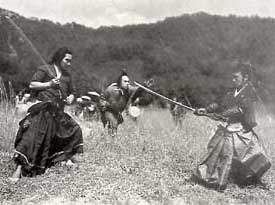 In 1913 the epic novel Boddhisatva toge (Great Bodhisattva Pass) began its original newspaper serialization. In 1913 the epic novel Boddhisatva toge (Great Bodhisattva Pass) began its original newspaper serialization.
Author Kaizan Nakazato (1885-1944) would add new chapters at intervals for the rest of his life, leaving it always open-ended. He never wrote an actual "final" chapter but always left the demented hero in some catastrophic cliffhanger.
Portions had already been adapted to the live theater in the 1930s, & in 1934 Hiroshi Inagaki scripted & filmed it for the first time in two parts with the unwieldy titles: Daibosatsu toge: Dai-ippen, Kogen itto-ryu no maki (1935); & Daibostatsu toge: Suzuko-yama no maki, mibu shiabara no maki (1936).
These featured the chambara superstar of the era, Denjiro Okochi, as the heartless, vicious hero Ryunosuke Tsukue.
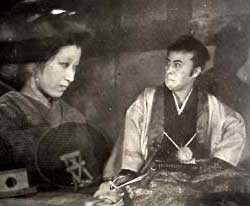 Other key roles included Fujiko Fukamizu as Omatsu whose grandfather is killed in the opening scene, & Takako Irie as the raped & widowed Omatsu. Other key roles included Fujiko Fukamizu as Omatsu whose grandfather is killed in the opening scene, & Takako Irie as the raped & widowed Omatsu.
Takako Irie was later in her career famed for her "ghost cat" roles, & a fine coincidence that this role provides her a ghost sequence after she is slain.
I've not thus far had the opportunity to see Inagaki's version which is not in circulaton but I know some of it, if not all, does survive. The two stills shown here convey the seriousness of the treatment.
From stills it's evident that, for example, the bamboo screen-slashing scene was filmed identically in later versions, right up to Okamoto's in 1966 classic version, so it's influence was permanent.
Nikkatsu had paid the equivalent of twenty thousand dollars for the rights, the most ever paid in Japan for film rights up to that time. It was a lavish production & was so popular among audiences that Nikkatsu's previously shaky existence was put on firm ground.
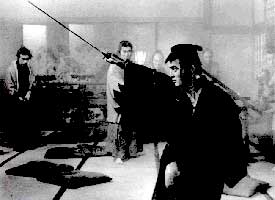 It was remade as a trilogy starring Chiezo Kataoka as Ryunosuke for Toei Studios in 1957-1959, quicky followed by the version starring Raizo Ichikawa, also as a trilogy, for Daiei studio (1960-1961), & last of all the internationally acclaimed version by Kihachi Okamoto widely known as Sword of Doom (Daibosatsu toge, 1966) which tells only the first third of the tale, though that is enough for Tatsuya Nakadai to have created what stands as the ultimate nihilistic hero. It was remade as a trilogy starring Chiezo Kataoka as Ryunosuke for Toei Studios in 1957-1959, quicky followed by the version starring Raizo Ichikawa, also as a trilogy, for Daiei studio (1960-1961), & last of all the internationally acclaimed version by Kihachi Okamoto widely known as Sword of Doom (Daibosatsu toge, 1966) which tells only the first third of the tale, though that is enough for Tatsuya Nakadai to have created what stands as the ultimate nihilistic hero.
As the story opens, we see Ryunosuke (Nakadai) kill a helpless old man (Kamatari Fujiwara) atop Great Bodhisattva Pass, an act that will leave the old man's granddaughter Omatsu (Yoko Naito) an orphan, though protected by a self-appointed "uncle" Shichibei the Thief (Ko Nishimura).
There was no reason for the killing, it was a plain act of murder, as if to test not his sword but to discover what he would feel, which apparently was nothing.
(However, my fellow chambara fan David Lovegrove pointed out to me how, since the old man had been praying for death, feeling himself to be a burden to his granddaughter, Ryunosuke may have appeared in answer to a prayer. I'd always thought this juxtaposition was merely ironic, but given the religious supernaturalism inherent in Nakazato's original novel, there would indeed be much more than irony in play.)
Even if Ryunosuke is a sociopath without emotion or concern for others, he nevertheless has in him an unachieved capacity to heal himself, as hinted at by his later sense of being haunted by his victims, a conscience after all, unless we are to believe his hallucinatory experiences are just further manifestations of madness & not guilt at all.
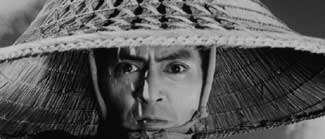 In a duel with Bunnojo (Ichiro Nakatani) of a rival school, using wooden swords (bokken) not intended to be lethal, Ryunosuke for the first time publicly displays a deceptive style of swordplay that draws in the opponent for the kill. In a duel with Bunnojo (Ichiro Nakatani) of a rival school, using wooden swords (bokken) not intended to be lethal, Ryunosuke for the first time publicly displays a deceptive style of swordplay that draws in the opponent for the kill.
It will be argued that the dishonesty of the style infected Ryunosuke's soul, which is the reason for what will eventually manifest not only as cruelty but outright madness.
When the judge sees that there is real hatred exuding from Bunnojo against Ryunosuke, & that Ryunosuke has in consequence adapted a sinister dangerous stance, the match is stopped by a cry of "Draw!" before it's engaged. But Ryunosuke, having raped Bunnojo's wife, is the object of such hatred that he is attacked, thus given the excuse he wanted to test his style, cracking his opponent's head & killing him.
This is followed by an amazing duel on a long rustic staircase in which the students of the slain sword instructor try for revenge.
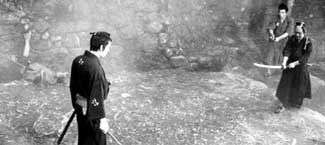 Calmly, almost prettily, Ryunosuke cuts down his attackers one by one. In all the day's killing he appears justified, as he was attacked in each case. But we know from the outright murder of the old man that this is what Ryunosuke wanted to do. Calmly, almost prettily, Ryunosuke cuts down his attackers one by one. In all the day's killing he appears justified, as he was attacked in each case. But we know from the outright murder of the old man that this is what Ryunosuke wanted to do.
Deplored even by his own father, who no longer sees Ryunosuke as suitable to inherit the training hall, he is banished from his village. He soon aligns himself with the Shinsen-group for a while, so that we catch glimpses of such historical personages as Isamu Kondo (Tadao Nakamaru) & his lieutenant Kamo Serizawa (Kei Sato).
He uses his skill to support the failing shogunate, not because he believes in Shinsen-gumi's politics but because it's a good job for a ronin who likes to kill. He is also followed by the woman he raped, Ohama (Michiyo Aratama), whose husband he killed, & they become lovers. And her former brother-in-law Hyoma (Yuzo Kayama) pursues Ryunosuke to avenge his brother.
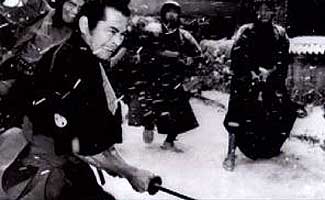 Famous sequences include his common-law wife's realization that the rapist she fell in love with will never stop killing innocent people, so she tries to kill him in his sleep, intending afterward to kill herself & the son they have had together. But she is killed by him, & the son abandoned. Famous sequences include his common-law wife's realization that the rapist she fell in love with will never stop killing innocent people, so she tries to kill him in his sleep, intending afterward to kill herself & the son they have had together. But she is killed by him, & the son abandoned.
Or the scene in the bamboo-screened room in which he believes he is pursued by the ghosts of his slain wife & the old man at Great Budhisattva Pass, insanely fighting his own guilt.
And the scene along the snowy lane in which the great swordsman Toranosuke Shimada (Toshiro Mifune!) is attacked by members of Shinsen-gumi & Ryunosuke stands aside awestruck as Shimoda cuts down men one after another.
Most film-goers around the world never knew what every Japanese viewer knew, that Kihachi Okamoto had filmed only part of the story.
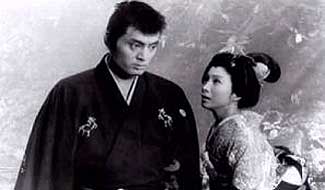 The film's success in the west had quite a different effect on the audience, for such viewers would rarely know that Ryunosuke was later blinded, & his eerie style would keep him nevertheless an undefeatable swordsman. The film's success in the west had quite a different effect on the audience, for such viewers would rarely know that Ryunosuke was later blinded, & his eerie style would keep him nevertheless an undefeatable swordsman.
Nor would the typical western viewer ever know Ryunosuke's heartless joy in killing would struggle within him against an equally maniac guilt for all the harm he caused, occasionally struggling toward a nobler path that his karma never permits him to sustain.
When in the climax there is a freeze-frame of Ryunosuke Tsukue still in the throes of psychosis killing & killing & killing & killing, it is not a "cliffhanger" that the story stops here, since western viewers wouldn't know there was supposed to be a second installment. Rather, this was a conclusive statement of Ryunosuke's fate: He will be fighting like this for all eternity.
Even if he succeeds, there's another all-against-one battle waiting in the wings -- a "loose thread" in Okamoto's film -- at which we're promised there'll be a gunman present.
Even for Japanese viewers familiar with the original serial novel & earlier more complete film versions, a cliffhanger could be seen as a conclusive statement. The novel had been written over a great length of time.
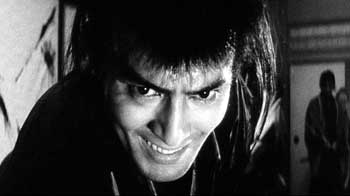 Each part ended with just such a cliffhanger, & the story was already being staged (& first filmed by Inagaki) while the author was still adding chapters. The author would die leaving it "unfinished" at a later point than Okamoto left it, but with the same ultimate effect. Each part ended with just such a cliffhanger, & the story was already being staged (& first filmed by Inagaki) while the author was still adding chapters. The author would die leaving it "unfinished" at a later point than Okamoto left it, but with the same ultimate effect.
So even if Okamoto had filmed the next two parts, the last third of the epic, so-called "Final," provides yet another cliffhanger as Ryunosuke Tsukue, mad as a hatter, drifts away in a flood on the roof of a house, rather like Captain Ahab waving farewell on the whale.
Quite obviously Ryunosuke will live & live & live always on his way to the next hill of aimless slaughter.
So Okamoto's one-third of the story really makes the same statement as the complete trilogy: Ryunosuke Tsukue, like Evil itself, is immortal.
copyright © by Paghat the Ratgirl
|
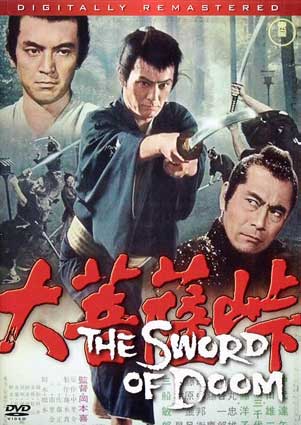

 Other key roles included Fujiko Fukamizu as Omatsu whose grandfather is killed in the opening scene, & Takako Irie as the raped & widowed Omatsu.
Other key roles included Fujiko Fukamizu as Omatsu whose grandfather is killed in the opening scene, & Takako Irie as the raped & widowed Omatsu.
 In a duel with Bunnojo (Ichiro Nakatani) of a rival school, using wooden swords (bokken) not intended to be lethal, Ryunosuke for the first time publicly displays a deceptive style of swordplay that draws in the opponent for the kill.
In a duel with Bunnojo (Ichiro Nakatani) of a rival school, using wooden swords (bokken) not intended to be lethal, Ryunosuke for the first time publicly displays a deceptive style of swordplay that draws in the opponent for the kill. Calmly, almost prettily, Ryunosuke cuts down his attackers one by one. In all the day's killing he appears justified, as he was attacked in each case. But we know from the outright murder of the old man that this is what Ryunosuke wanted to do.
Calmly, almost prettily, Ryunosuke cuts down his attackers one by one. In all the day's killing he appears justified, as he was attacked in each case. But we know from the outright murder of the old man that this is what Ryunosuke wanted to do. Famous sequences include his common-law wife's realization that the rapist she fell in love with will never stop killing innocent people, so she tries to kill him in his sleep, intending afterward to kill herself & the son they have had together. But she is killed by him, & the son abandoned.
Famous sequences include his common-law wife's realization that the rapist she fell in love with will never stop killing innocent people, so she tries to kill him in his sleep, intending afterward to kill herself & the son they have had together. But she is killed by him, & the son abandoned. The film's success in the west had quite a different effect on the audience, for such viewers would rarely know that Ryunosuke was later blinded, & his eerie style would keep him nevertheless an undefeatable swordsman.
The film's success in the west had quite a different effect on the audience, for such viewers would rarely know that Ryunosuke was later blinded, & his eerie style would keep him nevertheless an undefeatable swordsman. Each part ended with just such a cliffhanger, & the story was already being staged (& first filmed by Inagaki) while the author was still adding chapters. The author would die leaving it "unfinished" at a later point than Okamoto left it, but with the same ultimate effect.
Each part ended with just such a cliffhanger, & the story was already being staged (& first filmed by Inagaki) while the author was still adding chapters. The author would die leaving it "unfinished" at a later point than Okamoto left it, but with the same ultimate effect.